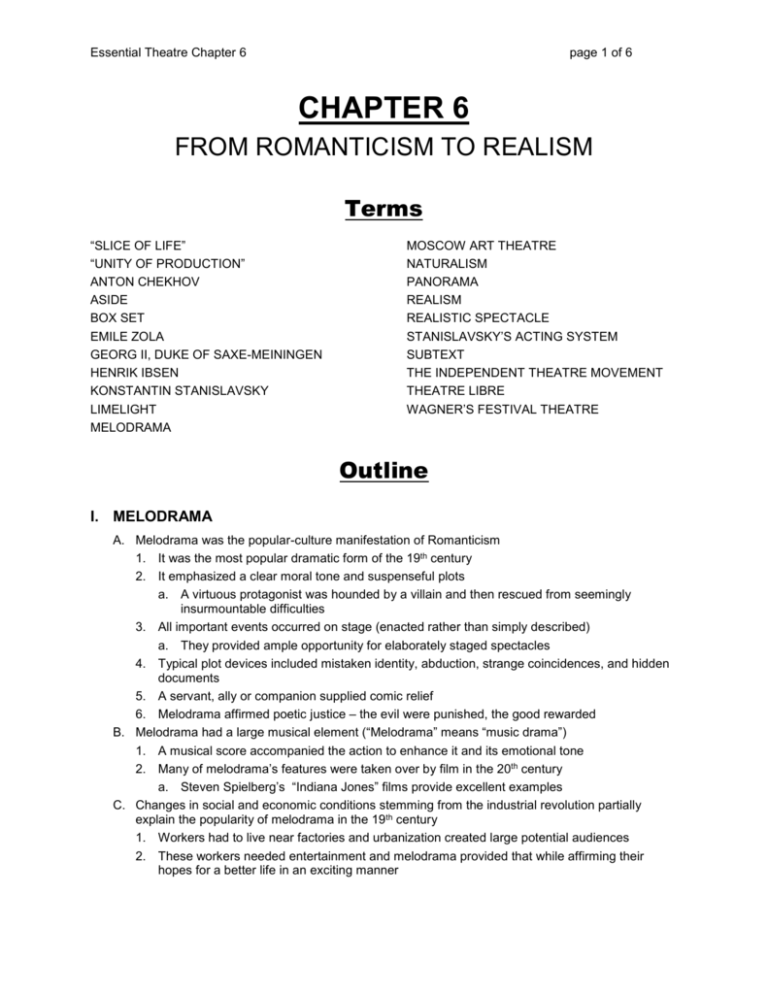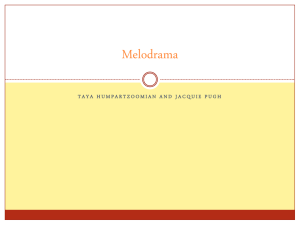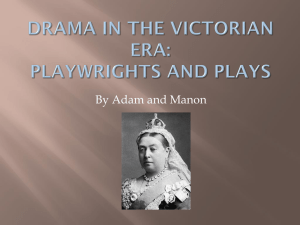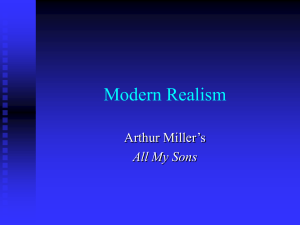Chapter 6 – From Romanticism to Realism
advertisement

Essential Theatre Chapter 6 page 1 of 6 CHAPTER 6 FROM ROMANTICISM TO REALISM Terms “SLICE OF LIFE” “UNITY OF PRODUCTION” ANTON CHEKHOV ASIDE BOX SET EMILE ZOLA GEORG II, DUKE OF SAXE-MEININGEN HENRIK IBSEN KONSTANTIN STANISLAVSKY LIMELIGHT MELODRAMA MOSCOW ART THEATRE NATURALISM PANORAMA REALISM REALISTIC SPECTACLE STANISLAVSKY’S ACTING SYSTEM SUBTEXT THE INDEPENDENT THEATRE MOVEMENT THEATRE LIBRE WAGNER’S FESTIVAL THEATRE Outline I. MELODRAMA A. Melodrama was the popular-culture manifestation of Romanticism 1. It was the most popular dramatic form of the 19th century 2. It emphasized a clear moral tone and suspenseful plots a. A virtuous protagonist was hounded by a villain and then rescued from seemingly insurmountable difficulties 3. All important events occurred on stage (enacted rather than simply described) a. They provided ample opportunity for elaborately staged spectacles 4. Typical plot devices included mistaken identity, abduction, strange coincidences, and hidden documents 5. A servant, ally or companion supplied comic relief 6. Melodrama affirmed poetic justice – the evil were punished, the good rewarded B. Melodrama had a large musical element (“Melodrama” means “music drama”) 1. A musical score accompanied the action to enhance it and its emotional tone 2. Many of melodrama’s features were taken over by film in the 20th century a. Steven Spielberg’s “Indiana Jones” films provide excellent examples C. Changes in social and economic conditions stemming from the industrial revolution partially explain the popularity of melodrama in the 19th century 1. Workers had to live near factories and urbanization created large potential audiences 2. These workers needed entertainment and melodrama provided that while affirming their hopes for a better life in an exciting manner Essential Theatre Chapter 6 page 2 of 6 D. Between 1800 and 1850, London’s population doubled. The number of its theatres grew from 2 or 3 to more than 20 1. Theatres sought to attract the largest possible audiences a. Melodrama and variety entertainment had the largest mass appeal 2. During the last half of the 19th century, each theatre began to aim its programming at a specific segment of the population BOX – Audience Behavior Some say that the influx of working-class spectators into the 19th-century theatre, and their behavior once there, drove away the more refined segment of the audience Comments made by foreign visitors to the English theatre support this conclusion, noting that the vocal audience response to the action sometimes seemed crude and distracting E. Because the pattern of melodrama is always the same, variety was gained through novelties: 1. Exotic locales 2. Water tanks for “aquatic” plays 3. Realistic spectacle (including onstage volcanic eruptions) 4. The latest technology and inventions were used, such as a camera in The Octoroon by Dion Boucicault (1859) 5. Dramatizations of popular novels or notorious crimes were performed F. After electricity became common in the 1880s, electric motors were used with treadmills for horse and chariot races 1. Moving panoramas were suspended at the rear of the stage, creating the effect that the horses racing around a track a. Ben Hur’s chariot race – in many theatres by 1900 2. The trend was toward ever more realistic effects a. Film inherited this tradition G. In melodrama, realistic spectacle, thrilling effects, novelty, suspense and the vindication of virtue were the major appeals 1. Whereas it encouraged the development of realism in visual aspects of theatre, melodrama clung to stereotypes in its characterization and moral outlook BOX – Scenes of Suspense and Spectacle in Melodrama Much of the appeal of melodrama lay in the suspense created by placing sympathetic characters in great danger and by their last-minute rescue Made more by attractive by spectacular scenic contrivances Uncle Tom’s Cabin – Eliza escapes from her pursuers (with bloodhounds) by floating across the Ohio river on a piece of ice BOX – The Appeal of Melodrama Melodrama validated the claim of ordinary people to a kind of aristocracy based on virtue and personal integrity rather than wealth and power It took the lives of common people seriously and paid respect to their superior purity and wisdom It held up ideals and promised rewards Its moral parable struggled to reconcile social fears with the period’s confidence in absolute moral standards, man’s upward progress, and a benevolent providence that insured the triumph of the pure Essential Theatre Chapter 6 page 3 of 6 II. THE ADVENT OF REALISM A. As melodrama was peaking in popularity, other theories and beliefs were undermining the absolutist moral values on which it depended B. In the late 19th century, a number of intellectual and scientific developments called many biblical passages into question. 1. Controversies erupted over discoveries in geology and anthropology 2. Charles Darwin’s The Origin of Species - 1859 C. Darwin’s theories had many implications: 1. Heredity and environment may influence everything humans are and do 2. Consequently, individuals cannot be held fully accountable for their actions 3. His theories strengthened the notion that progress (improvement) is inevitable 4. They contradicted the biblical account of creation 5. Humanity might be viewed as a part of nature, rather than set apart and superior to it D. These implications were crucial in the development of the modern temperament because they suggested that change is the norm 1. Concepts of right and wrong might vary from one society to another rather than stand as absolutes E. New ideas about human conscience were stated most fully in the writings of Sigmund Freud 1. Previously, most people believed that conscience is innate a. Melodrama is built on this premise 2. Freud theorized that conscience is relative to the individual and the process of socialization a. Socialization suppresses instinctive desires and urges b. We may never fully understand the motivations of others, nor even our own i. We must be aware of the subtext (covert meaning) beneath what is said and done F. According to this view, not only are moral values relative, but language and behavior are only partially reliable indicators of a person’s state of mind and motives G. This notion of relativity eventually affected nearly every area of thought and action, including the theatre III. REALISM AND NATURALISM A. Realism was first recognized during the 1850s; naturalism was first recognized during the 1870s. 1. Since around 1800, realistic scenery and costumes had been used to provide spectacular or picturesque background 2. But Realism and naturalism were based on the idea that environment shapes character a. Setting was reconceived of as an environmental factor and not merely a picturesque background b. Each play’s scenic needs were therefore viewed as unique and particular expressions B. The views of realists and naturalists were grounded in the scientific outlook – the need to understand human behavior in terms of natural cause and effect. Consequently: 1. Truth can only be verified through the senses 2. Playwrights should only write about the society around them, and do so objectively. a. Plays were written therefore about contemporary subjects b. Plays portrayed behavior not previously staged or thought of as fit for public presentation Essential Theatre Chapter 6 page 4 of 6 3. Controversy erupted over the portrayal of such “truths” 4. The real issue was the role of art in society a. Absolute versus relative values. b. Around 1880, Henrik Ibsen (often called the founder of modern drama) brought these issues into focus 5. The ending of Ibsen’s plays did not reaffirm accepted values a. Many of his plays were denied production because they were thought to be immoral and corrupting C. Nevertheless, these plays were widely read and discussed, especially because they were thought to challenge moral values and social norms BOX – Critical Reaction to Ibsen It is difficult for us to understand how violent a response Ibsen’s plays evoked when they first appeared Ibsen’s Ghosts admitted (publicly) that divorce and syphilis existed To many it seemed that Ibsen was attacking the family and violating common standards of decency Ibsen’s perception of women was also out of step with a time in which women were socially expected to accept a subservient role to their fathers or husbands “A woman cannot be herself in the society of the present day, which is an exclusively masculine society, with laws framed by men and with a judicial system that judges feminine conduct from a masculine point of view.” IV. THE EMERGENCE OF THE DIRECTOR A. Throughout history, someone assumed responsibility for staging plays 1. In the Greek theatre it was the playwright 2. In later times it was the head of the company, usually a lead actor or playwright B. A convergence of several complex developments led to the emergence of the modern director 1. The growing need for someone to coordinate and unify all the elements of a production a. In the past, scenic and costume elements were generalized and formalized, requiring little attention. C. Acting was also conventionalized during the period prior to the 19th century in that actors were hired according to lines of business. 1. Actors usually stood near the front of the stage and delivered their lines directly to the audience 2. Stage movement placed whomever was speaking at center - a convention all actors understood 3. Rehearsals were few D. As the 19th century progressed the theatre became more complex as the number and specificity of settings and costumes increased. 1. Melodrama’s effects required split-second timing and precise stage business 2. Box sets served to alter movement patterns 3. These changes required increased supervision, coordination and rehearsal 4. The need for greater unity and control became increasingly evident E. The acceptance of the modern director owes most to two influences: Wagner and SaxeMeiningen Essential Theatre Chapter 6 page 5 of 6 1. Richard Wagner sought to create “master artwork” through a fusion of all the arts a. Most of his stories for his operas are from German myths b. He wished to create a theatrical experience that would draw the audience out of its everyday, mundane existence into an idealized, communal, near-religious experience. F. To realize his goal, Wagner had a new kind of theatre erected in Bayreuth, Germany (1876) 1. It was the first modern theatre to do away with the box, pit and gallery arrangement 2. “Democratic” arrangement of seating - all audience members sit together in an arrangement that supposedly allowed everyone to see and hear the action equally well a. This arrangement set the pattern for most 20th century theatres 3. It was one of the first theatres to darken the auditorium during performances to more fully distinguish the world of spectators from that of the stage 4. Strong demand for “unity of production” – everything filtered through a single consciousness to achieve a unified artistic effect a. Most 20th century ideas about staging followed the unity of production principle G. Georg II, duke of Saxe-Meiningen, is now usually considered the 1st director in the modern sense 1. The ruler of a small German state 2. He owned his own theatre company 3. His company toured throughout Europe from 1874-1890 4. His fame stemmed from the company’s directorial practices 5. Saxe-Meiningen had complete control over every aspect of production 6. Crowd scenes were staged with great precision, variety, and emotional power 7. The total stage picture was worked out moment-by-moment 8. Saxe-Meiningen’s practice validated many of Wagner’s views V. THE INDEPENDENT THEATRE MOVEMENT A. By the 1880s, innovative plays by realists and naturalists had appeared, but censorship had kept most of them from production 1. The new drama and the new staging remained isolated from each other B. Throughout Europe, plays could not be publicly performed until a censor had approved them 1. Censors would not license some of Ibsen’s plays, but private performances were not subject to censorship a. A number of small, “independent theatres” exploited this loophole i. Open only to subscribing members ii. Not subject to censorship iii. The independent theatres were able to unite the new drama with the new staging techniques C. Independent theatres cropped up in France, Germany and England 1. The Théâtre Libre, founded in Paris by André Antoine in 1887, produced the plays of Zola and Ibsen 2. The Freie Bühne, which arose in Berlin in 1889, provided a hearing for new playwrights 3. In London, The Independent Theatre was founded in 1891 a. Its inaugural production, Ibsen’s Ghosts, created an enormous scandal b. It induced George Bernard Shaw to write plays that used comedy to provoke audiences into reassessing their values D. These independent theatres met an important need and also established a significant precedent for innovative theatre companies devoted to particular agendas or values Essential Theatre Chapter 6 page 6 of 6 E. The Moscow Art Theatre emerged from the independent theatre movement 1. Founded in 1898 by Konstantin Stanislavsky and Vladimir Nemerovich-Danchenko 2. Achieved its first major successes with the plays of Anton Chekhov a. Chekhov’s plays depict the monotony and frustrations of provincial life b. His characters conceal as much as they reveal in their responses c. In his plays subtext is often as important as the spoken lines d. His plays admit a complexity of human beings and action that don’t easily conform to strict dramatic types F. Stanislavsky’s system of acting – the most pervasive influence on acting during the 20th century – is one of the greatest contributions associated with the Moscow Art Theatre 1. Stanislavsky’s system contained several basic premises that are still considered the bestknown attempts to describe what is necessary for effective acting: a. The actor’s body and voice must be trained and flexible b. To act truthfully, the actor must be a skilled observer of human behavior c. Actors must understand a character’s motivations and goals in each scene and in the play as a whole, as well as each character’s relationship to all the other roles and to the dramatic action d. Actors may project themselves into the world of the play through the “magic if” e. Actors should concentrate moment by moment, as if the events were happening spontaneously and for the first time. G. Stanislavsky sought in his system to deal with all aspects of acting. BOX – Stanislavsky The Russian creator of the most influential acting system of the 20 th century Sought to achieve the highest level of ensemble playing in productions that would make the dramatic action clear through simple, natural acting, emphasizing inner truth rather than external effect Continued his search for a systematic approach to acting and published several books on aspects of it H. By the late 19th century, realism in the theatre was well established 1. A logical culmination of developments that began in the Renaissance 2. Melodrama and realism differed in their views of truth and values 3. By undermining Melodrama’s absolutist values, a pathway was opened for those ideas and practices that have come to be labeled “modernist”






